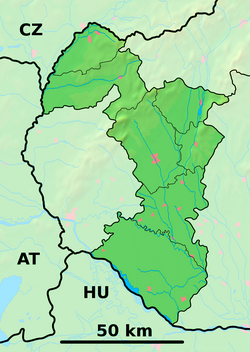Hlohovec
Hlohovec | |
|---|---|
Town | |
 Hlohovec, view from south | |
 Flag  Coat of arms | |
 Hlohovec Location of Hlohovec in the Trnava Region | |
| Coordinates: 48°26′00″N 17°48′12″E / 48.43333°N 17.80333°ECoordinates: 48°26′00″N 17°48′12″E / 48.43333°N 17.80333°E | |
| Country | Slovakia |
| Region | Trnava |
| District | Hlohovec |
| First mentioned | 1113 |
| Government | |
| • Mayor | Miroslav Kollár |
| Area | |
| • Total | 64.125 km2 (24.759 sq mi) |
| Elevation | 156 m (512 ft) |
| Population (2018-12-31[1]) | |
| • Total | 21,508 |
| • Density | 340/km2 (870/sq mi) |
| Time zone | UTC+1 (CET) |
| • Summer (DST) | UTC+2 (CEST) |
| Postal code | 920 01 |
| Area code(s) | +421-33 |
| Car plate | HC |
| Website | www.hlohovec.sk |
Hlohovec (German: Freistad(l) an der Waag, Hungarian Galgóc), is a town in southwestern Slovakia, with a population of 21,508.
Name[]
The name comes from *Glogovec, the Old Slavic name for a place densely overgrown by hawthorn. The Hungarian form Galgóc was adopted before a phonological change g > h in Slovak.[2]
History[]
The first written evidence of its existence is from 1113, when a town with the name Galgocz was mentioned in the so-called Second Zobor Document. In 1362 Hlohovec obtained town privileges. Ottoman troops captured city and annexed it to the sanjak of Uyvar as the Holok eyalet in 1663. Austrian troops retook it in 1685.
Landmarks[]

The dominant building is a Renaissance-Baroque castle built in 1720. The castle is built on the place of a pre-existing Slavic settlement and a medieval castle. In the castle area is the Empire theatre built in 1802, a riding school from the 18th century, and a Baroque garden pavilion.
In the middle of St. Michael Square stands the Gothic church of St. Michael with its highly decorated portal. Next to the church is the Chapel of Saint Anna from the 18th century. In the northern border of the central part of the town is the Franciscan church and monastery built in 1492. Part of the monastery premises nowadays occupies the Museum of National History and Geography.
The most visited and beautiful natural part of town is the castle park with its lake, French terraces, and rare wood-species, especially old sycamore trees.
Demographics[]
According to the 1910 census the town had 7749 inhabitants: 5645 Slovaks 1401 Hungarians and 667 Germans, 83.6% of the people were Roman Catholic, 13.7% Jewish and 2.1% Lutheran. According to the 2001 census, the town had 23,729 inhabitants. 97.85% of inhabitants were Slovaks, 0.72% Roma and 0.63% Czechs.[3] The religious make-up was 79.58% Roman Catholics, 14.85% people with no religious affiliation and 2.44% Lutherans.[3]
Famous people[]
- Heinrich Berté (1858-1924), composer of Dreimäderlhaus.
- Peter Burian (b. 1959), diplomat
- Ján Hollý (1785–1849), writer
- Miroslav Karhan (b. 1976), footballer
- Ladislav Kuna (1947–2012), footballer
- Jozef Seilnacht (1859–1939), altar builder
- , music composer and doom-pop artist, owner of brand "Kaváren"
- , (b. 1999) barista and artist, event manager, multitalent
Twin towns — sister cities[]
Hlohovec is twinned with:[4]
 De Panne, Belgium
De Panne, Belgium Hranice, Czech Republic
Hranice, Czech Republic Slovenske Konjice, Slovenia
Slovenske Konjice, Slovenia
See also[]
References[]
- ^ "Population and migration". Statistical Office of the Slovak Republic. Retrieved 2019-04-16.
- ^ Martin Štefánik - Ján Lukačka et al. 2010, Lexikón stredovekých miest na Slovensku, Historický ústav SAV, Bratislava, pp. 164, ISBN 978-80-89396-11-5. http://forumhistoriae.sk/-/lexikon-stredovekych-miest-na-slovensku Archived 2017-03-26 at the Wayback Machine
- ^ Jump up to: a b "Municipal Statistics". Statistical Office of the Slovak republic. Archived from the original on 2007-11-16. Retrieved 2007-12-15.
- ^ "Úvodná strana" (in Slovak). Hlohovec. Retrieved 2019-09-03.
Genealogical resources[]
The records for genealogical research are available at the state archive "Statny Archiv in Bratislava, Nitra, Slovakia"
- Roman Catholic church records (births/marriages/deaths): 1660_1901 (parish A)
- Lutheran church records (births/marriages/deaths): 1792-1928 (parish B)
External links[]
- Cities and towns in Slovakia

